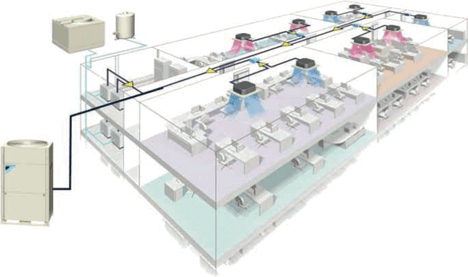Also, VRF systems usually don’t take up too much room, so you may be creative with how you put them in. But, compared to conventional HVAC systems, they can be more complicated to plan and set up, necessitating the assistance of trained professionals. Additionally, VRF systems have a larger initial cost, but the savings on energy over time can make up for it. To determine whether VRF systems are suitable for maximizing efficiency and performance, it is necessary to assess the unique requirements and intricacies of your building.
Upfront expenses:
There are a lot of advantages to variable refrigerant flow (VRF) systems, but they are more expensive than standard HVAC systems. Because VRF systems are inherently complex and require specialized components, their cost has increased. With their cutting-edge technology, variable refrigerant flow (VRF) systems provide more control over the refrigerant flow to specific interior units, making them more flexible and energy efficient than traditional systems. Higher initial costs are a direct outcome of the more involved installation methods and specialized equipment that are required by this level of complexity.
Optimizing performance and ensuring compliance with the building architecture are often extra issues that need to be factored into planning and design when using VRF systems. Many building owners and operators understand the long-term benefits of variable refrigerant flow (VRF) systems, which include reduced energy usage, increased comfort levels, and reduced maintenance costs, despite the larger initial investment. So, although the price tag might put some people off, the long-term advantages and efficiency gains more than make up for it.
Maintenance:
The upkeep of a Variable Refrigerant Flow (VRF) system does necessitate expert-level understanding and training, which may result in additional expenses for building operators. The refrigerant piping network is one of the sophisticated components that can be difficult to reach for repairs and maintenance. The intricacy of the system makes regular maintenance and inspections essential for achieving peak performance and extending its lifespan.
Cleaning filters, verifying electrical connections, and checking refrigerant levels are all part of this process to keep the system running smoothly and avoid efficiency drops. At an extra cost, you can reduce hazards and improve system reliability by hiring certified technicians who are experts in VRF systems. You can extend the life of your system and reduce the likelihood of operating disruptions by investing in correct preparation and upkeep plans. This will also help you avoid costly repairs in the future.
Refrigerant leaks:
Variable Refrigerant Flow (VRF) systems are vulnerable to a number of dangers and issues that might arise from refrigerant leaks. First, they can reduce the efficiency of the system because they lower the refrigerant charge, which affects how well the system transfers heat. Users typically see increased energy bills as a result of this inefficiency, as the system tries to make up for the refrigerant that gets wasted. Furthermore, the release of potentially dangerous greenhouse gases makes refrigerant leaks an environmental problem.
Hydrofluorocarbons (HFCs) and other refrigerants utilized in VRF systems add to the problem of ozone depletion and climate change. In addition, refrigerants are frequently poisonous or combustible, which means that leaks can cause safety issues for both professionals and building inhabitants. Energy consumption, resource depletion, and waste production are some of the environmental issues that might arise from the manufacturing and disposal of VRF equipment. Given the growing importance of sustainability in the eyes of building owners and developers, it is imperative that these environmental problems be adequately addressed in order for VRF technology to be widely used. To reduce the likelihood of these problems and maximize the system’s efficiency, performance, and compliance with safety regulations, it is crucial to implement leak detection protocols and conduct routine maintenance. The negative effects on the environment and the well-being of residents can be mitigated by taking preventative actions and quickly fixing leaks.
Climate limitations:
Although VRF (Variable Refrigerant Flow) air conditioning systems are economical and adaptable, they may not be able to handle very hot or cold weather. Extreme heat or cold could be too much for them, but they do best in mild settings where the weather is mostly stable all year. Extreme heat makes it difficult for VRF systems to cool spaces to a sufficient level, which can reduce their effectiveness and put unnecessary load on the system.
Similarly, if the outside temperature drops much below freezing, the system’s capacity to heat spaces efficiently may be reduced in extremely cold locations. In addition, VRF systems are susceptible to problems like condensation and diminished dehumidification capacities when exposed to extremely high humidity. Although variable refrigerant flow (VRF) air conditioning systems have several advantages when used properly, they may not work as well in very hot or cold climates and are thus better suited to milder areas.
Integration with other systems:
When it comes to integrating VRF systems with other building systems, such as BMS or EMS, custom solutions are usually required. Because many systems use different protocols, communication techniques, and data formats, synchronizing them can be a challenging task.
Specialized hardware or software interfaces are usually required for effective integration in order to allow the VRF system to communicate with other building systems. To achieve this goal of interoperability and smooth data interchange, it may be necessary to create middleware solutions or bespoke Application Programming Interfaces (APIs). Despite the obstacles, there are several advantages to a well-integrated system, such as better control, lower energy bills, and easier building operations.


